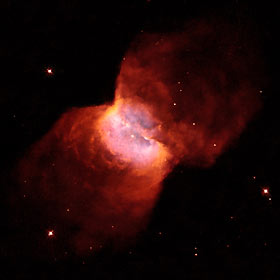
Enregistrez gratuitement cette image
en 800 pixels pour usage maquette
(click droit, Enregistrer l'image sous...)
|
|
Réf : S02588
Thème :
Nébuleuses (144 images)
Titre : Butterfly Nebula
Description : (La description de cette image n'existe qu'en anglais)
The Hubble Space Telescope's Wide Field and Planetary Camera 2 (WFPC2) is back at work, capturing this image of the 'butterfly wing'- shaped nebula, NGC 2346. The nebula is about 2,000 light-years away from Earth in the direction of the constellation Monoceros. It represents the spectacular 'last gasp' of a binary star system at the nebula's center. The image was taken on March 6, 1997 as part of the recommissioning of the Hubble Space Telescope's previously installed scientific instruments following the successful servicing of the HST by NASA shuttle astronauts in February. WFPC2 was installed in HST during the servicing mission in 1993. At the center of the nebula lies a pair of stars that are so close together that they orbit around each other every 16 days. This is so close that, even with Hubble, the pair of stars cannot be resolved into its two components. One component of this binary is the hot core of a star that has ejected most of its outer layers, producing the surrounding nebula. Astronomers believe that this star, when it evolved and expanded to become a red giant, actually swallowed its companion star in an act of stellar cannibalism. The resulting interaction led to a spiraling together of the two stars, culminating in ejection of the outer layers of the red giant. Most of the outer layers were ejected into a dense disk, which can still be seen in the Hubble image, surrounding the central star. Later the hot star developed a fast stellar wind. This wind, blowing out into the surrounding disk, has inflated the large, wispy hourglass-shaped wings perpendicular to the disk. These wings produce the butterfly appearance when seen in projection. The total diameter of the nebula is about one-third of a light-year, or 2 trillion miles.
|
|

